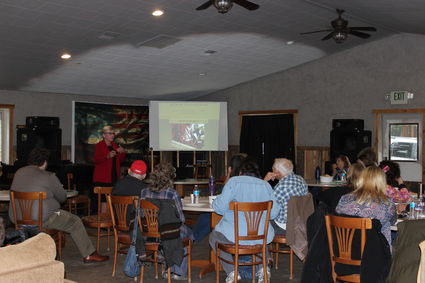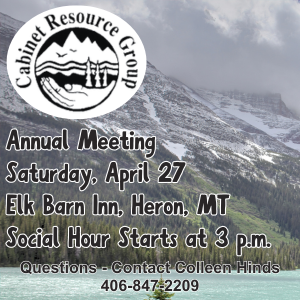Community discusses human trafficking
October 10, 2019

Miriah Kardelis
STATISTICS of human trafficking were shared by Natale Adorne during a community seminar last Thursday in Thompson Falls.
What is human trafficking? It is a form of modern-day slavery, according to Natale Adorne. It is a transaction that exchanges freedom for profit. It is "a crime that hides in plain sight," said Adorne, Program Manager for the Domestic Violence Programs at the Montana Law Enforcement Academy, because this is an infraction that you need to witness as it is happening. She added that it is an atrocious deception that takes place in our very own backyard; Montana.
Last Thursday, about 40 people from around the county gathered at Dignata Ranch in Thompson Falls to gain more knowledge from experts, including Adorne, in how to protect children from predators and drugs as well as warning signs and red flags of human trafficking and exploitation, with a strong focus on sex trafficking and internet safety.
Trafficking humans, worldwide, is a $150 billion criminal industry, with $99 billion alone, coming from sexual exploitation, said Adorne, a panelist at the seminar. In some cases, victims are physically forced, trapped, or coerced into commercial sex. In other cases, victims are intimidated and subjected for the intent of forced labor and made to work in illegal and inhumane circumstances. According to the Polaris Project, a non-profit, non-government organization that works to combat all forms of human trafficking, states, "the U.S. law defines human trafficking as the use of force, fraud, or coercion to compel a person into commercial sex acts or labor or services against his or her will. The one exception involves minors and commercial sex. Inducing a minor into commercial sex is considered human trafficking regardless of the presence of force, fraud, or coercion."
It is estimated at around 300,000 Americans under the age of 18 are trafficked every year. The economic laws of supply and demand come into play when buyers are willing to pay for commercial sex acts, in return making human trafficking a highly profitable market.
"Where's there's money, men and alcohol, you will find sex trafficking," expressed Adorne. She added that often times, traffickers will seek out a vulnerability in the victims they are pursuing. Using that weakness to their advantage, the traffickers will build an emotional attachment, which in return will isolate the victim from their family, their friends and from their entire life. While human trafficking can happen to anyone, there are several factors that will make an individual more susceptible to being trafficked, according to Adorne. Someone who has low self-esteem, someone who was previously neglected or abused, homelessness and poverty are all indicators that would allow the victim to be taken advantage of. "Humans are the endless profit margin. Humans can be sold over and over again, drugs can only be sold once," Adorne stated.
Adorne talked about the warning signs and red flags of someone who is being exploited for commercial sex. Warning signs include the sudden presence of an older boyfriend/girlfriend, a sudden supply of new items or expensive personal care, a person being secretive about who they are talking to or meeting, secretive online activity, isolation from regular friends and family, responding to online job offers for modeling or acting, overly submissive behavior, high levels of anxiety and more times than not a tattoo (known as branding) that the individual is unwilling to explain. Signs of labor trafficking include living with employer, poor living conditions, inability to speak to the individual alone, any answers that are given appear to be rehearsed, employer is holding identity documents, signs of physical abuse, submissive, and unpaid or paid very little. Adorne finished up her presentation with statistics such as 80 percent of trafficking victims are female and that 50 percent of them are children. Because of their emotional dependence to an adult and their inability to analyze consequences children seen as easy to groom, this makes them a high market value among buyers.
Traffickers can be anybody, according to Adorne, including family, friends or friends of the family. More times than not, a trafficker will be someone you or the victim knows. As a parent it is extremely important to have a handle of the social media use of your child, she said.
According to Brian Frost, a Training Officer for the Criminal Justice Information Network and the Montana Missing Person Clearinghouse, "You should know what social media apps they (your children) use, you should know what they have access to and who they are talking to at all times." An unfortunate part about keeping this knowledge pertinent is because there may come a time when you do have to report a missing person, Frost said. In the state of Montana, just last year alone, there were 1,847 missing persons reported to law enforcement agencies. "How long do you wait to report a missing person?" Frost spanned the room looking for answers. "24 hours? 48 hours? The answer is, you don't wait. A lot of times people will feel a sense of guilt for needing to call 911 to report a missing person. Don't ever feel guilty for using a service that is provided for you. Don't ever hesitate to call 911." When reporting a missing loved one there will be several questions that are asked. The more information you can give, the better, Frost said. =
Montana's missing persons clearinghouse website lists cases where no pictures have been provided, which is why Frost added that recent photos are one of the most important pieces of information you can give.
Law enforcement will also ask what the individual was last seen wearing, not just clothing but a description on any jewelry. Why is jewelry so important? Frost said itt is more individualized, and an unfortunate precedence, it doesn't decompose. X-rays and dental records are also informative identifiers. Questions will be asked about health concerns, vehicle information and about places the person frequently visits. Frost said kids in general will return to places where they are comfortable.
Frost notes that you will want to write down everything you've told the officer, as it will help you remember what you did say, and it will also help you remember what you didn't say. Frost also recommended keeping in constant contact with local law enforcement, making sure the profile on Montana's missing persons website (doj.mt.gov/missingpersons) is up to date at all times. Raju Manchala, a lead panelist speaker, closed the seminar with letting attendees know, "We all have a responsibility to do something, so we can make a difference; law enforcement can't do it alone, the government can't do it alone; you have to stand up and say, 'not in my community.'"







Reader Comments(0)